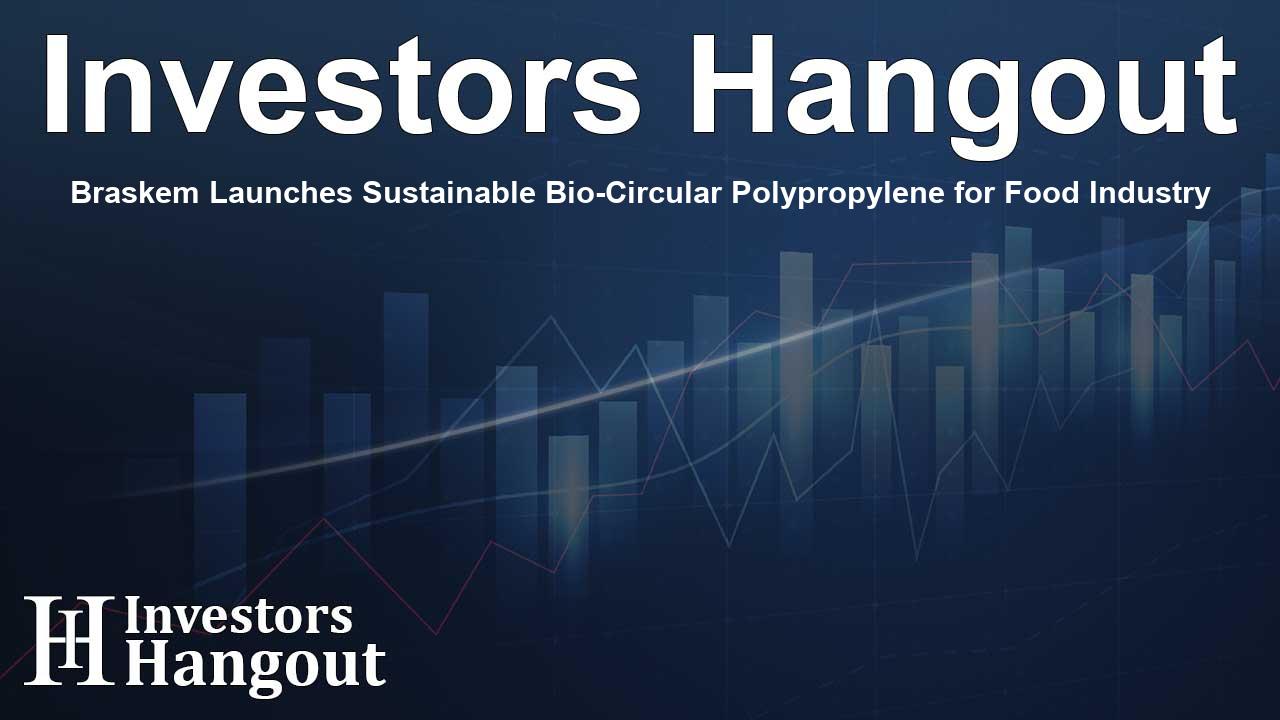Braskem Launches Sustainable Bio-Circular Polypropylene for Food Industry

Braskem's Innovative Approach to Sustainability
Braskem (B3: BRKM3, BRKM5, and BRKM6; NYSE: BAK) has unveiled its latest sustainable solution—bio-circular polypropylene (PP), branded as WENEW. As the leading producer of polyolefins in the Americas, Braskem is setting a remarkable standard by introducing this eco-friendly material tailored for the restaurant and snack food sectors. This product is derived from used cooking oil (UCO) and has received certification under the ISCC Plus mass balance program, marking a significant stride toward a more sustainable economy.
Driving Circularity in Food Packaging
Braskem's bio-circular polypropylene aims to drive circularity by transforming UCO into a valuable resource. By opting for this innovative solution, companies can significantly reduce their dependency on fossil fuels while enhancing their environmental credentials. Notably, bio-circular PP maintains equivalent properties and performance compared to traditional polypropylene, ensuring that clients experience a seamless transition in their manufacturing processes.
Market Relevance and Applications
Bill Diebold, Vice President of Polyolefins at Braskem America, highlighted that this sustainable polymer is being supplied to various converters supporting the Quick Service Restaurant (QSR) sector. The target users for this product span QSR chains, retail food suppliers, traditional eateries, and snack food manufacturers, particularly those looking to improve their cooking oil circularity. This versatile material is adept for a multitude of applications including food packaging, flexible films, and other consumer products.
Creating a Sustainable Supply Chain
The core of Braskem’s initiative lies in its commitment to sustainability through continuous improvement in the supply chain. UCO is collected and processed upstream to generate certified bio-circular ISCC Plus propylene. Collaborating with a network of suppliers, Braskem ensures that bio-circular feedstock is converted into polypropylene, thus creating a sustainable production loop. As a mass-balanced product, Braskem’s bio-circular PP easily integrates into existing production and recycling methods.
A Commitment to a Greener Future
“The launch of our bio-circular PP signifies a pivotal moment in the pursuit of sustainability within the restaurant and snack food industries. By integrating this innovative solution, businesses can play a crucial role in enhancing circularity and minimizing their environmental footprints,” emphasized Courtney Keller, Sustainability Commercial Manager at Braskem America.
Braskem’s Vision and Objectives
Braskem’s aspiration is clear: by 2030, the company aims to cut its scope 1 and 2 greenhouse gas emissions by 15% and achieve carbon neutrality by 2050. This vision solidifies Braskem’s position as a leader in the production of materials derived from renewable resources and biobased raw materials. The focus on reducing greenhouse gas emissions not only aligns with global sustainability efforts but also reinforces the company’s commitment to environmental stewardship.
About Braskem
With an innovative outlook targeting sustainability and societal well-being, Braskem strives to contribute significantly to the Circular Economy. The company employs nearly 9,000 dedicated professionals who focus on delivering sustainable chemicals and plastic solutions. Its extensive portfolio spans various sectors including food packaging, construction, automotive, healthcare, and more. With a rich infrastructure of 40 industrial units across Brazil, the United States, Mexico, and Germany, Braskem proudly exports its products to over 70 countries.
Braskem America: Leading Polypropylene Production
As a wholly owned subsidiary of Braskem S.A., Braskem America is a prominent polypropylene producer in the United States. With five production facilities in Texas, Pennsylvania, and West Virginia, as well as an Innovation and Technology Center in Pittsburgh, Braskem America is on the forefront of leveraging advancements in biotechnology and advanced materials. For more details, interested parties can visit the Braskem website.
Frequently Asked Questions
What is bio-circular polypropylene?
Bio-circular polypropylene is a sustainable material derived from used cooking oil that maintains the same properties as traditional polypropylene.
How does Braskem's bio-circular PP benefit the environment?
This innovative product helps reduce reliance on fossil fuels and promotes circularity by repurposing used cooking oil.
Who are the primary users of bio-circular polypropylene?
The main users include quick service restaurants, retail food suppliers, traditional restaurants, and snack food manufacturers.
What are Braskem's sustainability goals?
Braskem aims to reduce scope 1 and 2 greenhouse gas emissions by 15% by 2030 and achieve carbon neutrality by 2050.
How does bio-circular PP integrate into existing processes?
Bio-circular polypropylene can be easily integrated into existing production and recycling methods, making the transition seamless for manufacturers.
About Investors Hangout
Investors Hangout is a leading online stock forum for financial discussion and learning, offering a wide range of free tools and resources. It draws in traders of all levels, who exchange market knowledge, investigate trading tactics, and keep an eye on industry developments in real time. Featuring financial articles, stock message boards, quotes, charts, company profiles, and live news updates. Through cooperative learning and a wealth of informational resources, it helps users from novices creating their first portfolios to experts honing their techniques. Join Investors Hangout today: https://investorshangout.com/
Disclaimer: The content of this article is solely for general informational purposes only; it does not represent legal, financial, or investment advice. Investors Hangout does not offer financial advice; the author is not a licensed financial advisor. Consult a qualified advisor before making any financial or investment decisions based on this article. The author's interpretation of publicly available data shapes the opinions presented here; as a result, they should not be taken as advice to purchase, sell, or hold any securities mentioned or any other investments. The author does not guarantee the accuracy, completeness, or timeliness of any material, providing it "as is." Information and market conditions may change; past performance is not indicative of future outcomes. If any of the material offered here is inaccurate, please contact us for corrections.